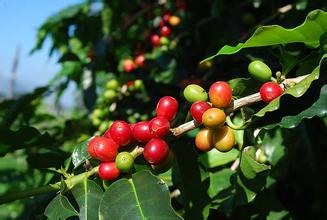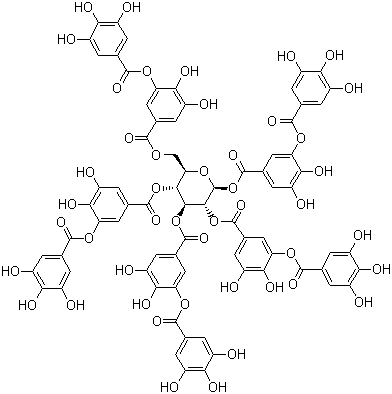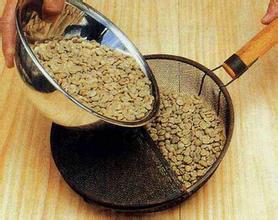The difference between the three native species of coffee and the introduction of Arabica and Robusta

Coffee belongs to the evergreen shrub of the genus Rubiaceae, which is centered in the tropics. There are about 6000 species of Rubiaceae belonging to 500 genera. Coffee has always been considered to have certain effects, such as invigorating the stomach, waking up the brain, stopping bleeding, dissipating heat, strengthening the body and so on. There are about 40 species of coffee plants, but the only ones that can produce coffee beans of commercial value are Arabica, Robusta and Liberian. these three species are called the "three native species of coffee".
Arabica species:
The origin of Arabica species is the Abyssinia Plateau of Ethiopia (now the Ethiopian Plateau). It developed the habit of baking and drinking in the 13th century and was introduced into Europe from the Arab region in the 16th century. it has become a favorite drink all over the world.
Arabica coffee accounts for 75% of all coffee, accounting for 80%. It has excellent flavor and aroma, making it the only coffee that can be drunk directly among these native species. But its resistance to dryness, frost, diseases and insect pests is too low, especially the natural enemy of coffee-leaf rust. Sri Lanka is a case in point. Sri Lanka used to be a well-known coffee producer, but coffee farms were not spared by leaf rust at the end of the 19th century. Since then, Sri Lanka has turned to the development of black tea industry, and the same list of black tea estates as India.
Arabica coffee beans are mainly grown in South America (except parts of Argentina and Brazil), Central America, Africa (Kenya, Ethiopia, etc.), Asia (including parts of Yemen, India and Papua New Guinea).
Robusta species:
The leaf rust-resistant varieties found in Congo in Africa have stronger disease resistance than Arabica. In fact, the Robusta species was originally a mutant of the Congolese species.
Arabica coffee beans grow in the cold tropical high-sea areas, and the high-temperature and humid zone that is not suitable for Arabica coffee is where Robsta coffee grows. Robusta species are commonly used in instant coffee (which extracts about twice as much liquid as Arabica), bottled coffee, liquid coffee and other industrial coffees. The content of caffeine is about 3.2%, much higher than 1.5% of Arabica species.
The main producing countries are Indonesia, Vietnam and West Africa with C ô te d'Ivoire, Algeria and Angola as the center.
Liberian species:
West Africa is the origin of coffee grown in Liberia. It has a strong ability to adapt to all kinds of environments, whether high or low temperature, humid or dry, except that it is not resistant to leaf rust and its flavor is worse than that of Arabica, so it is only traded in some West African countries (Libya, C ô te d'Ivoire, etc.). Or planted for research.
About 65% of the coffee in circulation in the world market is Alibika:
According to the statistics of ICO (International Coffee Organization), excluding the domestic transactions of coffee-producing countries, about 65% of the coffee in circulation in the world market is Arabica and 35% is robusta. Arabica species are characterized by slender and flat grains, while robusta coffee beans are more round.
But if you add in the hybrids of Arabica and robusta (for example, the mutant Colombian subspecies, which is the main variety of Colombian coffee, has a 1x4 robusta pedigree and is therefore resistant to leaf rust and has high yield) and its mutant secondary coffee beans, the classification will be more complicated. Some Arabica coffee beans are quite close to the native species, while others are similar to the Robusta species.
Source:
VisibleCafe's blog
Important Notice :
前街咖啡 FrontStreet Coffee has moved to new addredd:
FrontStreet Coffee Address: 315,Donghua East Road,GuangZhou
Tel:020 38364473
- Prev

A brief discussion on the "culprit" of the astringent taste of coffee-- Tannin to understand the cause of the astringency in coffee
Tannin coffee tannic acid coffee contains a variety of ingredients, extraction is not to extract all of these ingredients, there is usually such a rule: if the amount of coffee powder is fixed, the amount of soluble components extracted depends on the degree of grinding and time. The finer the grinding degree of coffee powder is, the longer the extraction time is, the more ingredients will be obtained. According to the experiment, if the quantitative coffee powder can be extracted
- Next

A brief introduction to the technical skills of using hand net to bake coffee beans at home
Hand net is also called manual roaster. The biggest advantage of hand net baking is that it can remove smoke, avoid the smoky taste of coffee, and make it easier to observe the changes in the appearance of beans during baking. When baking coffee beans with a hand net, the firepower is fixed in a strong medium fire. After fixing the firepower intensity, the distance between the hand net and the flame is adjusted according to the firepower intensity. The position of the hand net and the tile
Related
- What is the meaning of lactic acid fermentation with coffee bean treatment?
- How to judge the state of foam by sound?
- How does the latte pull out the unicorn pattern? Come to get for a little trick to improve the flower pull!
- Will flower pulling affect the taste of the latte?
- Do you know the history of coffee?
- The difference between honey treatment and sun washing what is raisin honey treatment?
- What kind of milk can a novice use to make coffee foam to keep the foam longer? The correct method and skills of milking tutorial sharing
- Why do washed coffee beans taste sour? Flavor characteristics of washed Coffee
- Introduction to the skill of how to practice the size and height of water injection around the circle of hand-brewed coffee
- How do beginners practice coffee flower drawing from scratch?

